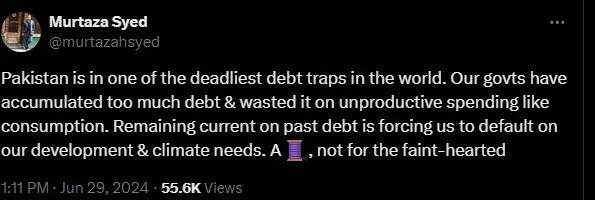Former Governor of State Bank of Pakistan (SBP) Dr Murtaza Syed raised alarm bells on Saturday, saying that Pakistan is engulfed in “one of the deadliest debt traps in the world”.
In a series of tweets on Saturday, Dr Syed, who also served as the acting governor of the SBP in 2022, highlighted the South Asian country’s current debt situation calling for a “far more prudent route” to reprofile Pakistan’s debt.
“Pakistan is in one of the deadliest debt traps in the world,” he said.
“Our governments have accumulated too much debt and wasted it on unproductive spending like consumption. Remaining current on past debt is forcing us to default on our development and climate needs.”
Dr Syed said the Pakistani government is paying more to service debt than any other country in the world and will continue to do so for the next several years.
“This necessitates punitive and unrealistic taxes to pay for old debt and leaves no real resources to invest in Pakistan,” he said.
“As seen in Kenya recently, this is putting Pakistan on a dangerous path toward social discontent,” warned the policymaker.
Citing data from UN Trade and Development (UNCTAD) debt dashboard, Dr Syed said that at 6%, “Pakistan’s government pays more on interest as a share of the economy than any other country in the developing world”.
Pakistan ‘is bankrupt’ and ‘sinking deeper every year’: Atif Mian
Whereas, at 65%, Pakistan’s government has the second-highest interest payments to government revenue ratio in the world, after Sri Lanka, he said.
“As a result of this heavy interest rate burden, the government has no resources left for social spending. This is terrible as social spending is critical for upgrading the skillset of our population and boosting the quality of jobs, exports and foreign investment in the economy.”
Dr Syed shared the Pakistani government spends almost three times more on interest payment than on education, which is the second worst ratio in the developing world after Sri Lanka.
“Similarly, the government spends almost six times more on interest than it does on health, a ratio that is only worse in Yemen, Angola and Egypt.”
“Clearly, repaying interest on debt is crowding public spending on education and health in Pakistan, which is one of the lowest in the world,” he noted.
“Finally, the government pays two times more on interest than on investment, which is critical for growth, a ratio that is only worse in Angola and Lebanon. Pakistan currently invests only 14% of GDP, less than half what is generally considered as necessary for sustained growth,” he said.
Dr Syed was of the view that the debt burden are not just artefacts of the current high interest rates in Pakistan and globally.
“On all the above metrics, Pakistan’s interest bill has been among the highest in the world for the last four years, even when interest rates were much lower,” it added.
“So this problem reflects Pakistan’s heavy debt burden and not high interest rates. And it is here to stay,” it said.
He added that even if Pakistan’s revenues were to “miraculously increase” by a large 2% of GDP over the next couple of years, interest would still eat up around 55 % of government revenues
“One way to solve the problem is to try to boost government revenue by increasing taxes but this will take time and can backfire, as demonstrated in Kenya recently …
“Similarly, spending cuts can only go so far as the debt burden is too onerous. A far more prudent route would be to reprofile Pakistan’s debt so that resources can be freed up to spend on development and the climate,” he concluded.
Read the full story at the Business Recorder - Latest News website.


